documenta 15
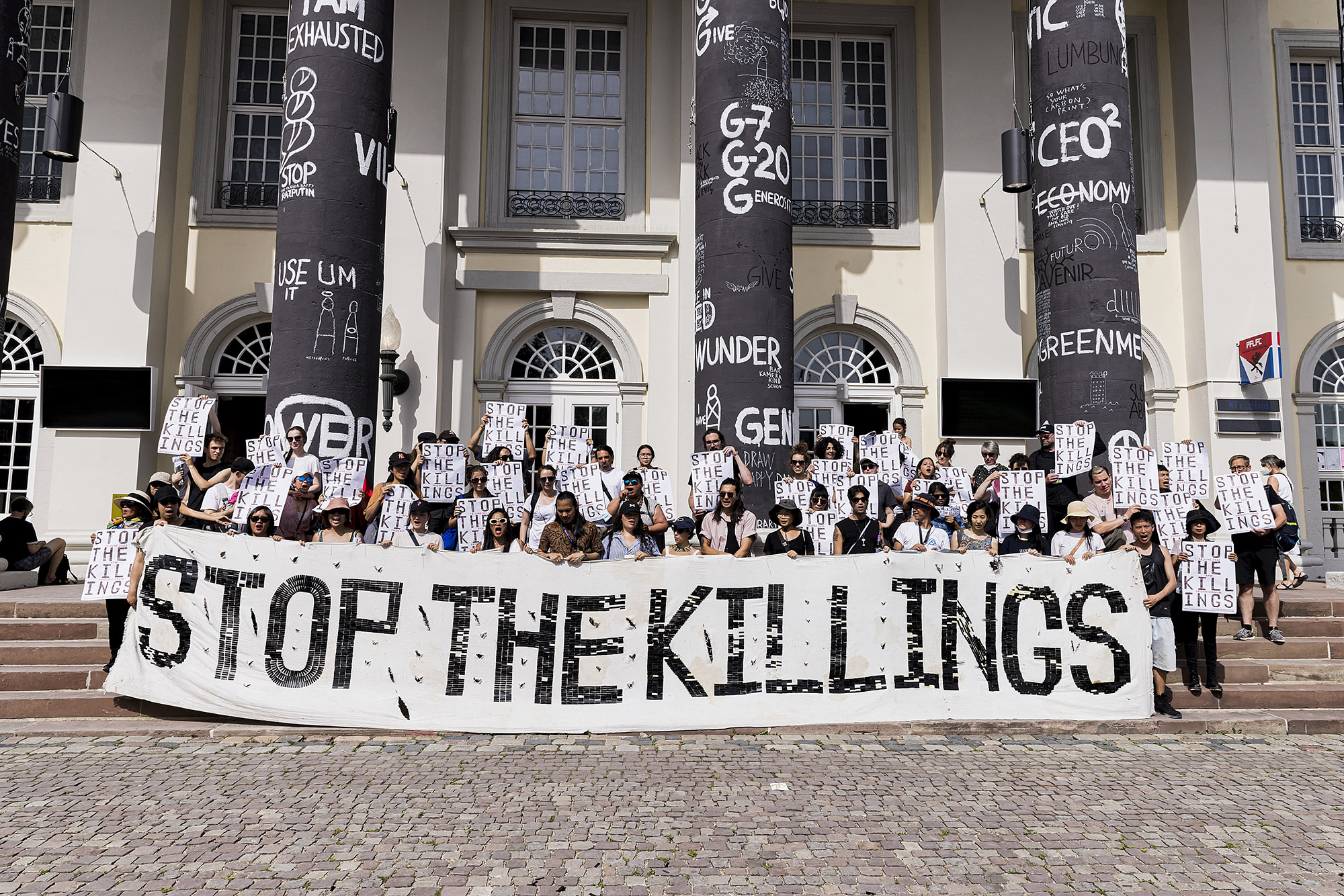
ruangrupa’s documenta fifteen: a Paradigm-Shifting and Heart-Warming Celebration of Grassroots, Solidarity Economy, and Voices from the Global South that Deserves our Full Attention, Despite the Show's Mismanagement of Antisemitic Imagery and Miscommunication.
"From each according to his abilities, to each according to his needs."
Karl Marx
Before the whole thing went sour, following several accusations of antisemitism and communication faux pas, documenta fifteen’s energy was quite exhilarating and inspiring during its preview days. It all started with a cheerful press conference in a stadium — how low-key and working-class of the organisers — which was where the evening’s party was also hosted. Open to everyone, with meat and vegan sausages and beer and live bands, it was not unlike being on the side-lines of a large music festival, seating on the terraces and the floor, and chatting with your [new and old] friends — with the occasional whiff of Indonesian fragrant clove cigarettes travelling from the smoking areas.
The visit to the exhibition venues themselves is an exercise in mindset adjustment, however. The show embraces the practice of collectivity wholesomely and comes with an impressive inventory of sitting arrangements, from sofas to rugs to wood pallets to plastic crates to crafted constructions to regular chairs—to the detriment of, say, readability, clear wall texts, contextualisation, and a clearly marked itinerary of artworks installed and lit on par with museum standards. Having said that, the conviviality and contents of the show still win you over, held by values such as “nongkrong”, the Indonesian word for “hanging out together”, and “lumbung”, or rice barn, referring to the practice of sharing resources by Indonesian farming communities—so those multiple living rooms make sense in that environment. Going through the show is also like unpacking an infinite series of Russian dolls, except when you start opening them up it seems that their contents grow exponentially, with an increasing number of participants. Each invited collective or lumbung artist opens doors to more collectives and lumbung artists.
This idea thrives in several locales, such as in the Fridericianum, an important exhibition venue in Kassel dating back to 1779, which became Fridskul [Fridericianum as school] for the occasion, with its monumental Greek columns covered with Romanian artist Dan Perjovschi’s political dry humour, in words and cartoons. Inside, various collectives spanning from nearly every continent are deployed side by side, documenting their on-going practices and state of affairs—ruangrupa insisted that an important part of their presentation is to spotlight current practices, as opposed to creating ad-hoc arrangements for Kassel. And it seems that the collectives may be sleeping there too. The ground floor is occupied on one side by RURUKIDS, a free space for children to play, mingle, interact with art, sound, and so on; we didn’t linger but I appreciate the gesture—children are the future after all. And on the other side, similarly playground-looking, by Gudskul, an educational organisation and art space created in 2018 by three Jakarta-based collectives including ruangrupa.
The most radical act brought by documenta is not eye-opening or shocking art, but pedestaling solidarity economy and current practices deployed by those who are in the midst of it—and aren’t mediated by, say, a superstar contemporary artist—and care about social and human issues, despite their lack of means in their respective geographies. It's not Burning Man nor the Paris Commune nor the Non-Aligned Movement, but neo-lumbung is somewhere socialistically there.
On the top floor, you can watch a series of films, archival and recent, curated by Komîna Fîlm a Rojava [The Rojava Film Commune] — a collective of filmmakers based in Rojava, in northern Syria, and founded in 2015 to bring awareness and education through films, for the empowerment of local communities. It is all the more poignant that the autonomous region of Rojava has a traumatic relationship to the medium, since a suspicious fire burned down a cinema in Amuda in 1960 with more than 280 children inside. Additionally, lack of cultural investments and on-going conflicts [forceful assimilation by the Syrian state, occupation by Daesh] lead to the closure of all the cinemas in the region in 2011. It contributed to the decline of local customs and culture, which are particularly rooted in oral traditions and music — think, singing for the small and grand events of life, from harvesting to wedding to baking bread in your kitchen. The quality of the documentaries and musical clips I sampled, some grave, some humorous— all well-made — are worthwhile on their own. The collective also presents a program at Gloria Kino, an arthouse for independent films in Kassel — along another program curated by the excellent collective of researchers, curators, and filmmakers Subversive Film, which focuses on historic works related to Palestine, film preservation, and research, out of Ramallah and Brussels.
Other collectives included are Siwa plateforme, an artistic laboratory focused on social development, and rooted in the precarious Tunisian town of Redeyef since 2011 — one of the world’s largest phosphate basins, we are told. With more than forty contributors, Siwa features written stories of lived injustices, installations, films, and sounds, all aiming at connecting this marginalised territory to the world, via Kassel. Nearby, is Project Art Works, a UK-based organisation that supports and promotes work made by neurodivergent practitioners [and who were on the shortlist for the last Turner prize]. Here, they recreate their studio in Hastings, in a dynamic display [mostly paintings and works on paper] that is said to evolve over time. Elsewhere, collectives working on archives such as Asia Art Archive, from Hong Kong, Archives des luttes de femmes en Algérie [Archives of Women’s Struggles in Algeria], and The Black Archives [which documents the history of Black emancipation movements and individuals in the Netherlands] exhibit their on-going research projects.

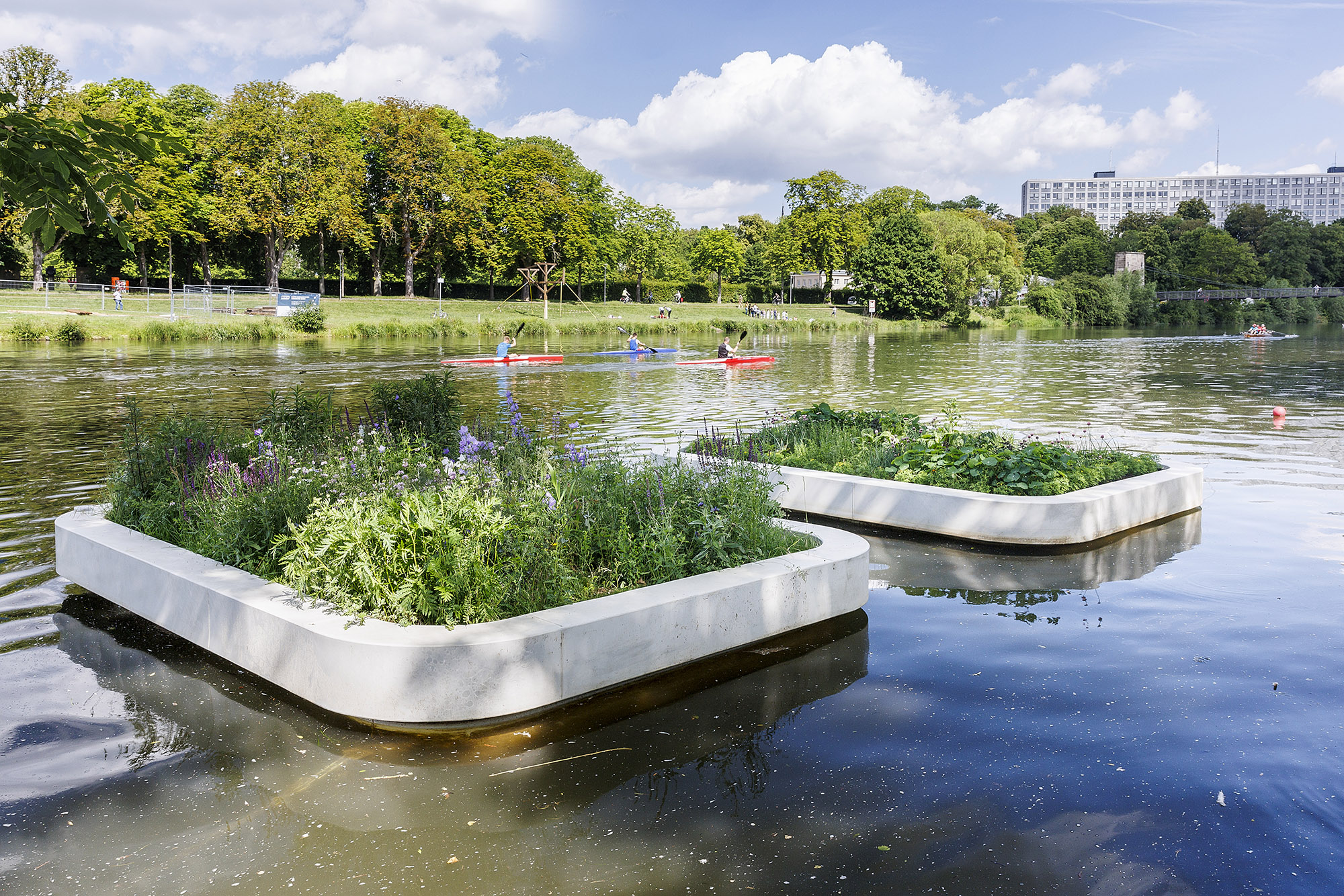
1. documenta fifteen: Friedrichsplatz, Richard Bell, Embassy Talk 2022, exhibition view. Photography: Nils Klinger
2. documenta fifteen: OFF-Biennale Budapest, Ilona Németh, Floating Gardens [Future Garden, Healing Garden], 2011-2022, exhibition view, Bootsverleih Ahoi. Photography: Frank Sperling
Thrown amid the varied hanging-out places, Fridskul shows some artworks made by individuals [and their collaborators, obviously]. For instance, we see a new series [mostly 2022] of figurative paintings by Aboriginal Australian artist and activist Richard Bell featuring Aboriginal Australians protesters holding banners that read slogans such as “We Want Land, Not Handouts” or “Why Pay to Use Our Land”. The theme is on par with Bell’s tent installation in front of Fridskul, Tent Embassy [2013–ongoing], which is inspired by the Aboriginal Tent Embassy, a protest tent standing since 1972 in front of the Parliament House in Canberra, Australia. Elsewhere there are also the colourful figurative tapestries by Małgorzata Mirga-Tasa, a Polish-Romani artist and activist [who also represents Poland at the Venice Biennale this year] who here offers scenes of celebration of Roma daily life, in an attempt to challenge the negative stereotypes often associated across Europe with this community. Her works are part of the great contributions made by OFF-Biennale Budapest, an independent organisation founded in 2015 in Hungary, whose artistic projects can be found here and at the Bootsverleih Ahoi, by the Fulda River [the latter is described as “a space that oscillates between the concepts of playground, junkyard, and construction site”, which sounds about right]. In the basement, Uzbek filmmaker and educator Saodat Ismailova [and the 18 artists from Kazakhstan, Kyrgyzstan, Tajikistan, and Uzbekistan, she invited to work with her] occupies several cave-like spaces with an installation called Chilltan [in reference to a Central Asian shapeshifter and spiritual healer]. It offers texts on paper and screens, eerie silk curtains, multicoloured Uzbek pillows, and films; and features narratives and symbols rooted in folk shamanism and animism, such as the tale of Bibi Seshambe [central Asian Cinderella if you will, one of the many Cinderella stories across the world], wishing trees, shamanic, potentially trance-inducing drumming, and traditional healing practices.
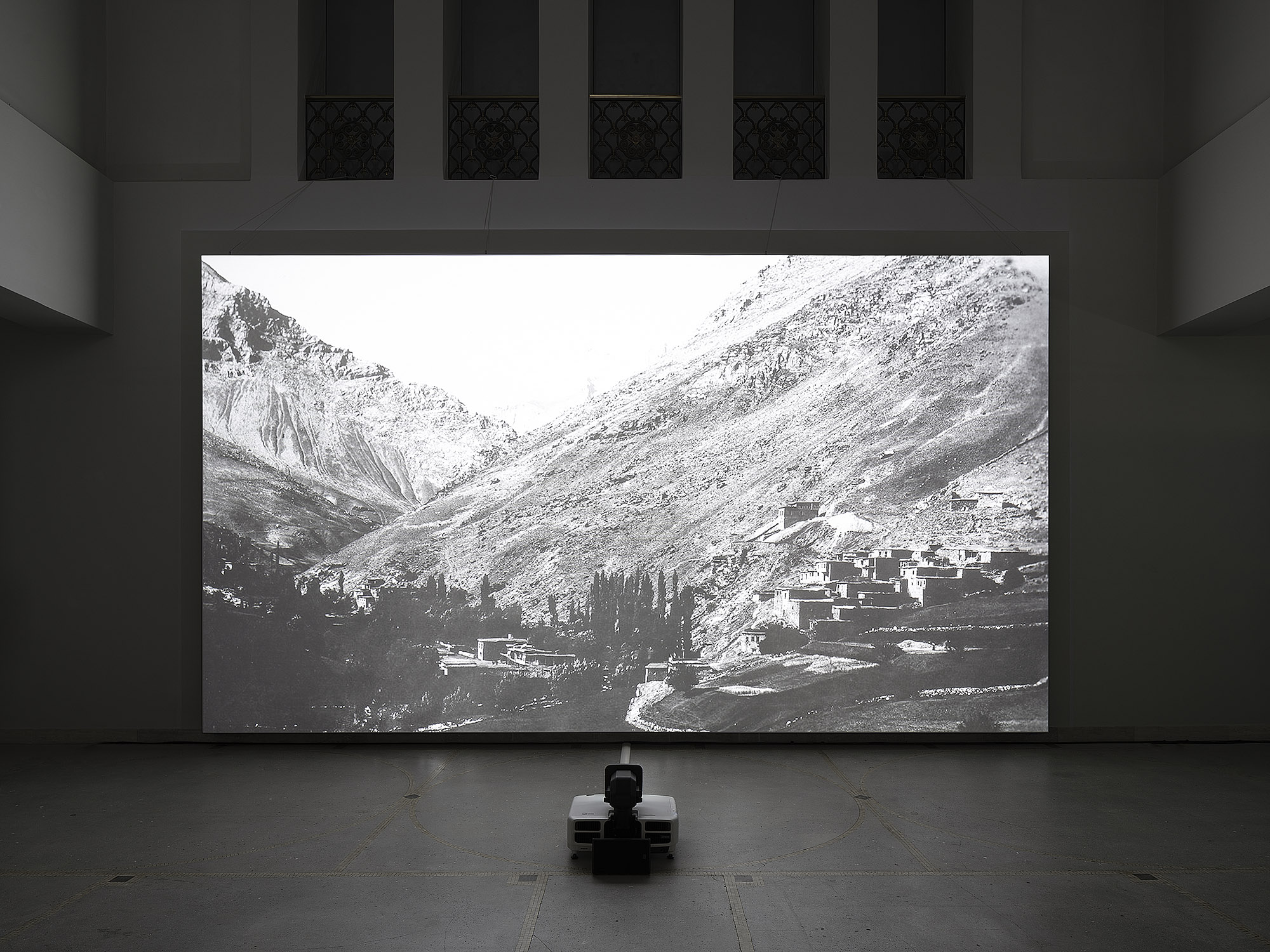
documenta fifteen: Pınar Öğrenci, Aşit’/Avalanche / Lawine, 2022, exhibition view, Hessisches Landesmuseum, Kassel. Photography: Nicolas Wefers
Travel through geographies and time continues, following underlying themes of indigenous self-determination, the salvaging of ancestral — yet active — traditions, and resistance from the side-lines [to capitalism, to the post-imperial, and the post-colonial]. At the Hessisches Landesmuseum, Pınar Öğrenci's film Aşît [2022] mesmerises. It shows breath-taking landscapes of the snow-caped mountains surrounding the town of Müküs in south-eastern Turkey at the border with Iran, blended with archival images and scenes from the daily lives of its inhabitants. If today’s Müküs is mainly populated by Kurdish-speaking communities, you could hear Armenian, Kurdish, Farsi, and Arabic spoken on its streets until the 1915 Armenian genocide. It was once the cradle of Armenian civilisation [and the Urartian civilization that came before it], with nature-loving traditions such as planting walnut trees for every new born male [sadly, the trees are now seen as bad luck]. To the touching voice of folk singer Hayrik Mouradian, Öğrenci’s film blends beauty and tragedy together, poking at the wounds endured by this locale throughout the 20th century, with perhaps chess-playing as its only escape. In the same venue upstairs, FAFSWAG, a collective of Māori and Pacific LGBTQI+ artists founded in 2013 in New Zealand, presents an augmented reality installation called Atua. Titled after underworld deity figures from the pan-Pacific cosmological belief systems, it unveils said deities, who share fragments of their stories to tablet-holding visitors.

documenta fifteen: Agus Nur Amal PMTOH, Tritangtu, 2022, exhibition views, Grimmwelt, Kassel. Photography: Nils Klinger
Sumatran performer, educator, and artist Agus Nur Amal PMTOH’s modern storytelling intervention through household objects at Grimmwelt Kassel is a highlight of documenta fifteen. At the core of his work is theatre and collaboration for trauma healing and peace-making. His kaleidoscopic constructions and self-made TV set stages combine a multitude of toy-like details where poetry and humour are at the service of community empowerment activities. In Kassel, he worked with school children on themes such as pollution of the local river and feeling of hopelessness for what the future holds, but for instance, back in 1999–2002, in Jakarta, he joined an Anti-Violence Community to mediate student riots and police shooting [civil unrests which eventually led to the fall of President Suharto and his New Order regime]. His combination of singing declamations and vocalisations are powerful, humorous, and somehow spiritual — I assisted to his snippet performance during the press conference — that is as seductive as it is effective.
At Hübner areal — a first-time venue for documenta, and former manufacture building of buses and trains parts — curator Mirwan Andan [amongst others] is seen talking to statues in Sebastián Díaz Morales’s film Smashing Monuments. In Andan's case, he converses with the Selamat Datang Monument, in central Jakarta, a towering bronze statue of a young man and a young woman holding hands high which was built to welcome foreign athletes to the 1962 Asian Games. Somehow, he brings the statue to life through imagination and context, by asking the couple if they will be moving to the new capital — the overcrowded and rapidly sinking Indonesian capital is to be moved to Borneo in the coming years — and wonders if they come down from their high plinth at night to enjoy fried rice from the food stalls, when no-one is looking.
The interweaving of macro and micro-economic concerns — and their impacts on common people's lives — is a common thread throughout the exhibitions. Point in case in another room, a newly commissioned five-channel installation with large projections by Filipino artist and activist Kiri Dalena, Pila [Lines, 2022], portrays Filipinos waiting in line for some rice at a local community pantry — in a country where the lockdowns are some of the strictest, paired with harsh punitive measures and extremely expensive Covid tests. Dalena's film nearly reads as a durational performance, where people are stationary at first in the dark [some join the hours-long line in the middle of the night], but, as the sun rises, they move with it. People consented to be filmed while sleeping or chatting about daily life, exchanging tips to make rice last longer, politics, and such, making for a tropical quiet street scene and peaceful work that yet reveals the vulnerability of unpredictable social reality of the Philippines. Also at the Hübner areal are exhibitions within exhibitions by Sa Sa Art Projects, an arts collective founded in 2010 in Cambodia, who will use some of documenta fifteen's funds towards a community studio in Phnom Penh; the clay-focused Indonesian Jatiwangi art Factory [JaF, founded in 2005] collective, which was born out of the necessity to revitalise a region enduring different economic tremors; Malian Festival sur le Niger [founded in 2009], the largest such event in West Africa, engaged culturally but also economically and socially in the region; Danish safe haven for refugees Trampoline House [2010–2020, which then reopened, albeit smaller, thanks to documenta fifteen in 2022]; and Guangzhou-based BOLOHO, whose “business model is based on friendship”; and others.
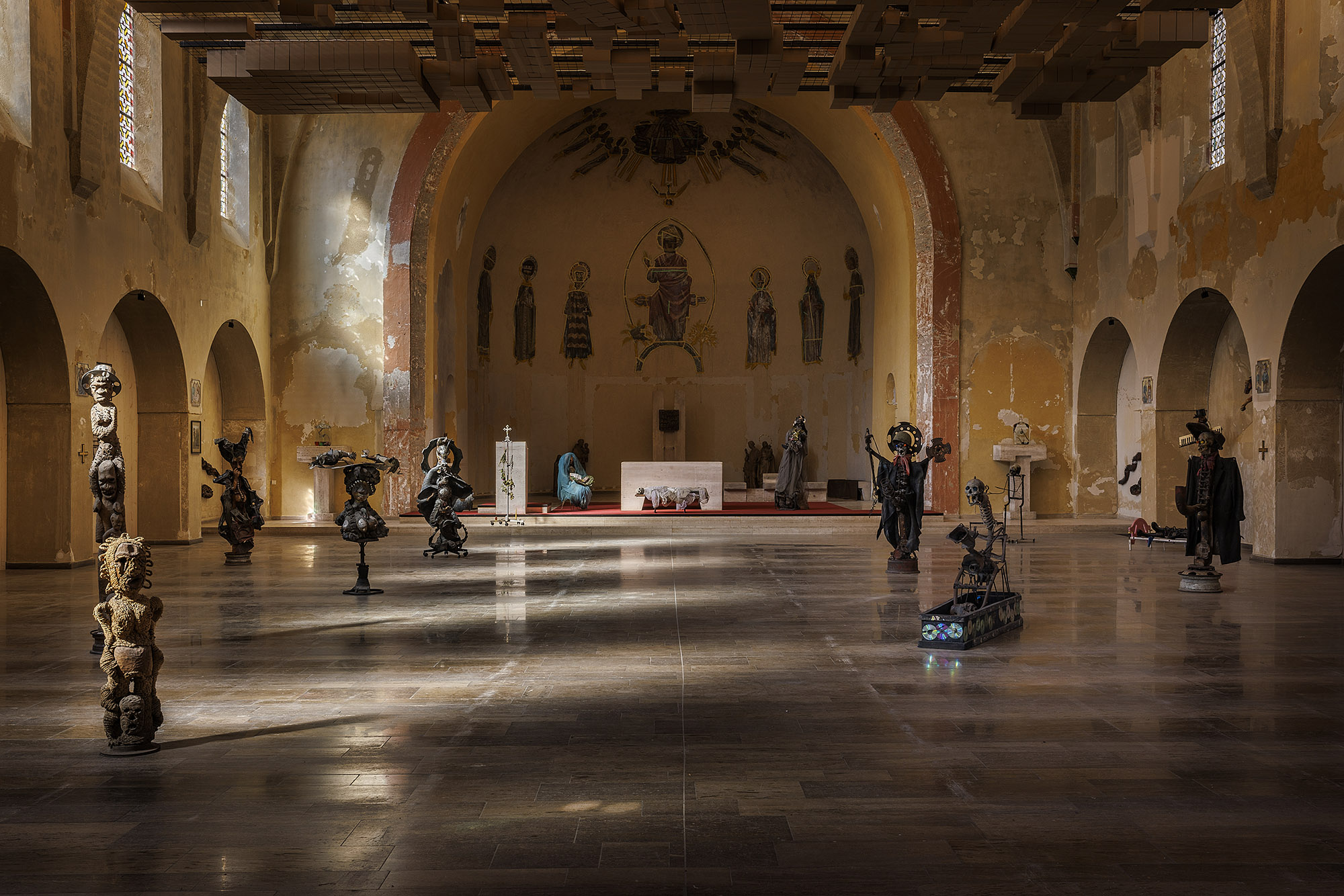
documenta fifteen: Atis Rezistans | Ghetto Biennale, 2022, exhibition views, St.Kunigundis, Kassel. Photography: Frank Sperling
Then comes the standalone presentation by Atis Rezistans [Resistance Artists], centred around the artist André Eugène [and more than 35 participants] at the St. Kunigundis Roman Catholic Church [built in 1927]. They couldn’t realise the last edition of the Ghetto Biennale [first established in 2009] in Haiti, and are investing this atmospheric location instead with films, installations, sculptures, and performances, transcending junk materials into worship-worthy gorgeous voodoo and allegorical objects, creating spiritual bridges between the Catholic Church and their presence. On the lawn outdoors, you can sample clay cookies in a caravan/installation offered by artist Michel Lafleur and his collaborators.

documenta fifteen: Taring Padi, Sekarang Mereka, Besok Kita [Today they’ve come for them, tomorrow they come for us], 2021, exhibition views, Hallenbad Ost, Kassel. Photography: Frank Sperling
Nearby, Indonesian collective Taring Padi's [founded in 1998] magnificent overtake of the interiors and exteriors of the former swimming pool Hallenbad Ost [a Bauhaus building constructed in 1929 and closed in 2009, another first-time venue for documenta] is arresting. A short side-line is necessary here: the collective is the one caught in the second antisemitic scandal surrounding documenta fifteen—the first scandal came with the inclusion of Palestinian collective The Question of Funding, accused of ties to the Boycott, Divestment and Sanctions movement [BDS], a Palestinian-led movement promoting those actions against Israel — for their work People’s Justice on the Friedrichsplatz, a large banner with dozens of caricatured characters collectively painted in 2002, when the then politicised students and artists-in-the-becoming addressed their dismay, frustration, and anger at the loss of many friends in the Indonesian 1998 riots. It wasn’t up yet during the preview days [and, having the experience of things not being ready when I visit exhibitions during press and professional days, I do not believe that it was on purpose], but was quickly covered and then removed for two adverse representations of Jews and the Mossad. It would have been more interesting to open the discussion and ponder the question of who brought the antisemitic imagery to Indonesia some 20 years ago — historically, antisemitic representations are often imported, by colonial and imperial powers alike, who fill educational vacuums wherever they operate. Admittedly, just like Adolf Hitler nearly made it on the cover of The Beatles’s 1967 album Sgt. Pepper's Lonely Hearts Club Band, someone should have flagged the racist imagery, especially considering the subsequent outrage they provoked, but I am personally one of those who doesn't believe in this being a calculated provocation. Back to Hallenbad Ost — Taring Padi shows many other collective paintings, woodcut posters, painted signs, banners, and Wayang-inspired puppetry [planted as a theatrical landscape on the lawn in front of the venue], tackling issues such as fair Indonesian general elections, Black Lives Matter, corruption, polygamy, militarised violence, Papuan and other human rights matters, help to the most vulnerable, and so on. It creates an all-engulfing environment with a multitude of peculiar colourful characters and caricatures which stylistic polyphony blends together delightfully, like a being in the midst of a benevolent crowd.
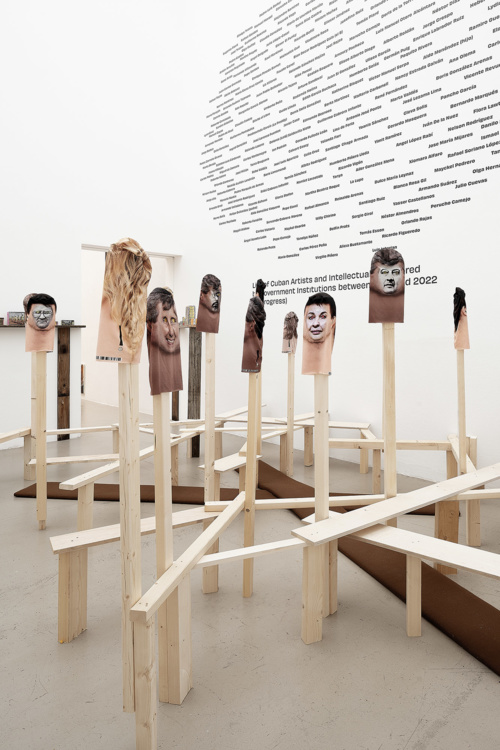
documenta fifteen: Instituto de Artivismo Hannah Arendt [INSTAR], List of censored Artists, 2022, Photography: Nicolas Wefers
At the Documenta Halle, the postmodern constructivist building realised in 1992 for documenta 9, more collectives coexist. The Dhaka-based Britto Arts Trust, an artist-run non-profit collective founded in 2002, takes over [with nearly 140 participants] a large wall with Chayachhobi [2022], a mural of aggregated scenes from Bengali movies featuring food, famine, and war; and rasad [2022], a shop-like installation of food items in crochet, ceramic, metal, and embroidery, in line with their work on zero waste food and socio-politically engaged projects. Nearby, the Havana-born [in 2015, initiated by artist and activist Tania Bruguera] Instituto de Artivismo Hannah Arendt [INSTAR] collective, which is engaged in civic literacy and social justice in Cuba, presents various installations, including one that lists the names of Cuban artists and intellectuals censored by local government institutions. In a far corner, a space has been transformed into a bean-bag cinema showing the eccentric movies of Wakaliwood, or Ramon Film Productions. Born in 2005 in Wakaliga, a slum in the Ugandan capital Kampala, as an artistic and social experiment in film, their low-budget productions manage to be epic. It belongs to the it’s so bad it’s good category, delivering fight movies where kung-fu, ridiculous special effects, fake blood, comedy, and action burst into violent but also funny and surreal narratives, all the while keeping local youth and adults off drugs and trouble and giving them great creative purpose.
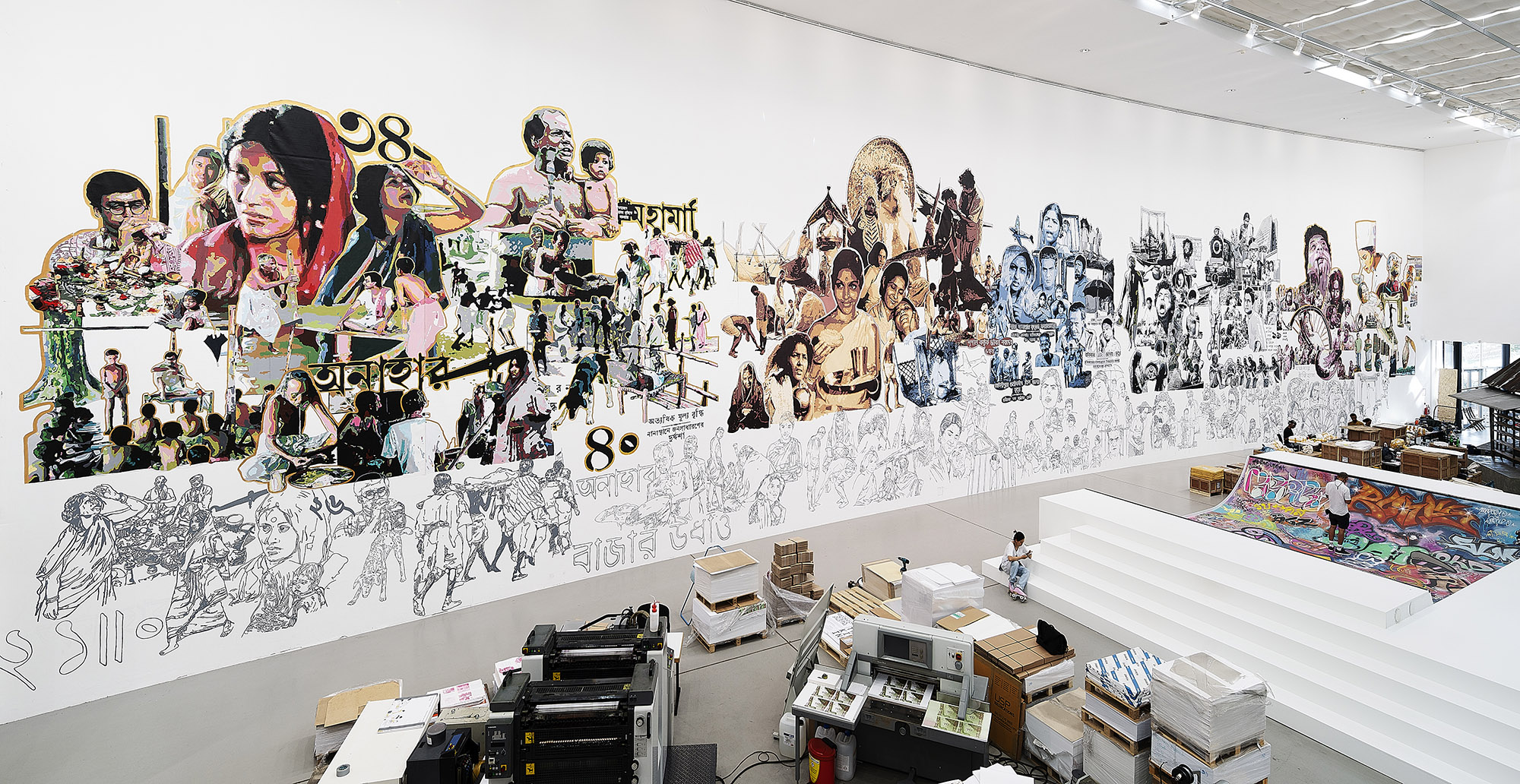
documenta fifteen: Britto Arts Trust, ছায়ািছব [Chayachobi], 2022, exhibition views, Documenta Halle, Kassel. Photography: Nicolas Wefers
During the pre-opening days, I met scholar Werner Kraus, who is recognised for his writing and research on the pioneering Indonesian Romantic painter Raden Saleh. He shared with me that Arnold Bode, the founder of Documenta in 1955, had organised an international art exhibition of European modern art, including Bauhaus artists such as Wassily Kandinsky, that toured in Indonesia in 1929—inspiring many locally and connecting both modern art scenes conceptually. My wish is that we continue such exchanges, with the understanding that you can’t hold people accountable and responsible, and demonise them at the same time. This documenta fifteen—and my writing only but sampled some of the great presentations on show, and didn’t mention the rich programme of music and performance that makes this a genuine practice and community-based experience—gives visibility and recognition to people who cruelly lack both internationally (and sometimes locally). Not only do those voices matter, they also bring rich spices and flavours to our international art cuisine, and make it all the more interesting.
Cristina Sanchez-Kozyreva is an art critic, curator and writer. She is a regular international contributor to art publications such as Artforum, Frieze, Hyperallergic, and other publications including the South China Morning Post. She was the co-founder and editor-in-chief of Hong Kong-based independent art magazine Pipeline that ran print editions form 2011 to 2016 where she curated thematic issues with artists, curators and other art contributors. She has a Masters degree in International Prospective from Paris V University. She is the editor-in-chief of Curtain Magazine.
Proofreading by Diogo Montenegro
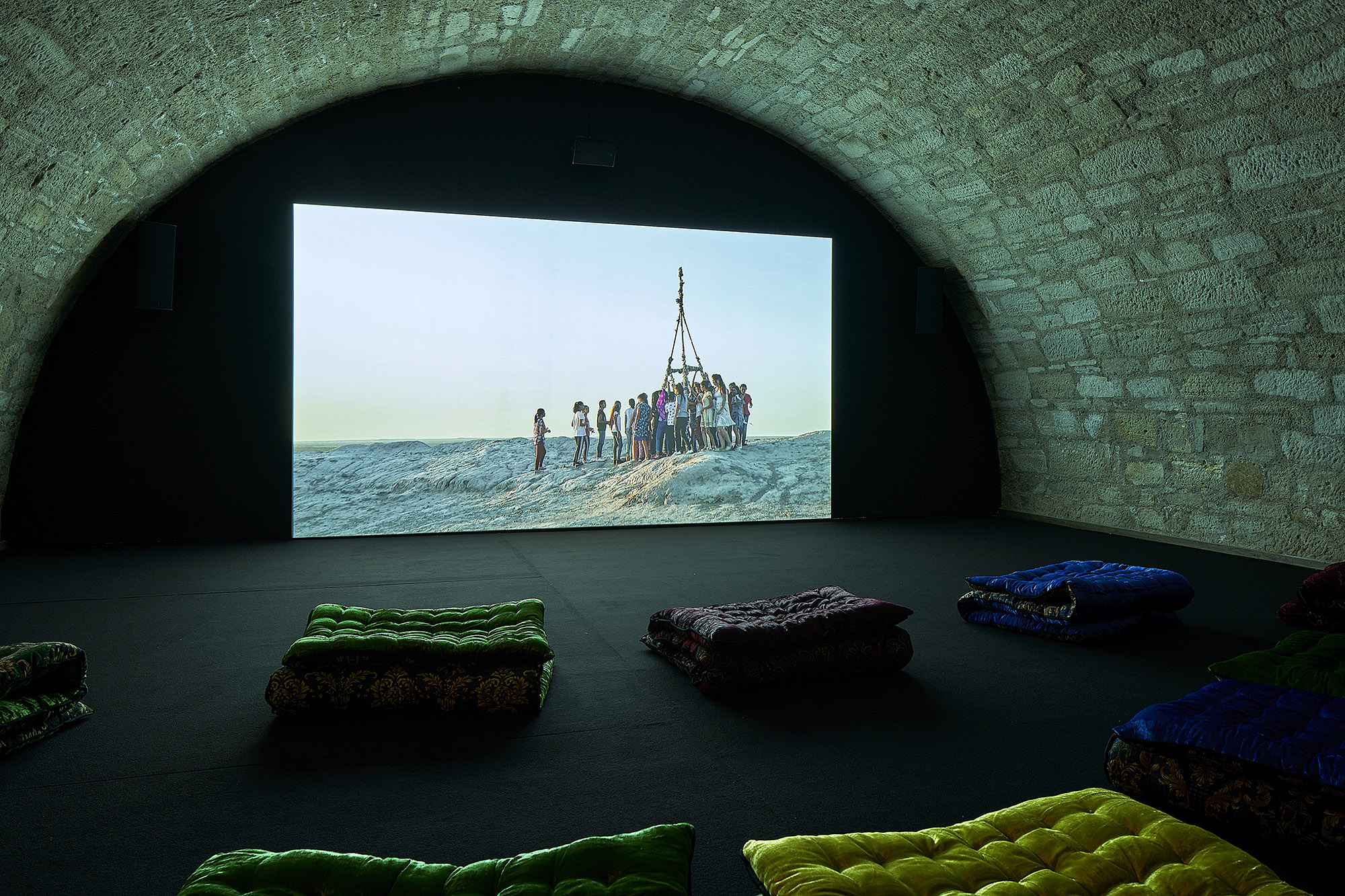
documenta fifiteen: Saodat Ismailova, Chillpiq, 2018, exhibition views, Fridericianum, Kassel. Photography: Nicolas Wefers
Cover Image: Kiri Dalena, Respond and Break the Silence Against the Killings [RESBAK], Friedrichsplatz, Kassel. Photography: Victoria Tomaschko
